Abstract
Analyzing some specific activities within a commercial structure gives useful hints on organizational management concepts. Particularly, the interactions among customers, staff, and facilities can underline lights and shadows, and offer some possible ideas to improve service and customer satisfaction. This paper will study the checkout process at a PAK’nSAVE store through direct observation. Staff and self- checkout processes will be analyzed, providing figures and tables to clarify the findings. Based on the research, some points will be discussed, including nonvalue added activities for both customer and staff, possible improvements, and already implemented concepts. A final overview will highlight some crucial ideas in management operations, including the importance of a proper location and the forecasting ability.
PAK’nSAVE Checkout
Founded in 1985, PAK’nSAVE is a discount food warehouse chain that aims at providing quality food at a reduced cost. Since 1997, the New Zealand company has offered the lowest food prices in the country every year (“Our policy”, 2019). To achieve this goal, PAK’nSAVE has implemented two main guidelines. First, it purchases large volumes of basic daily products to share cost-saving with its customers. Secondly, it has developed a practical store format, where shelving, lighting, and other interior structures have functionality as the only logic. Verifying the effective practicality of a standard PAK’nSAVE store and analyzing how customers interact with internal facilities can provide useful insights into business operational key concepts as developed by the management of the New Zealand company.
PAK’nSAVE Store at Mount Albert
The PAK’nSAVE store selected to conduct this research is located at Mount Albert, in the immediate surroundings of Auckland. The location has several relevant features to deepen the philosophy and policy of PAK’nSAVE. Mount Albert is a densely populated urban area, constituting a strong catchment area. Moreover, the warehouse is strategically placed along the New North Road, one of the main arteries linking Auckland with the suburbs, and it can be reached through the motorway.
The research was conducted on a Saturday afternoon at about 5 p.m. when the store was crowded. The focus of the observation was the checkout area, where three different modalities of interaction are available for customers. Most counters are run by the PAK’nSAVE staff, including a small number reserved to those clients who buy up to 20 items. The third zone is the self-checkout area. In fig. 1, the three areas are identified with different colors.
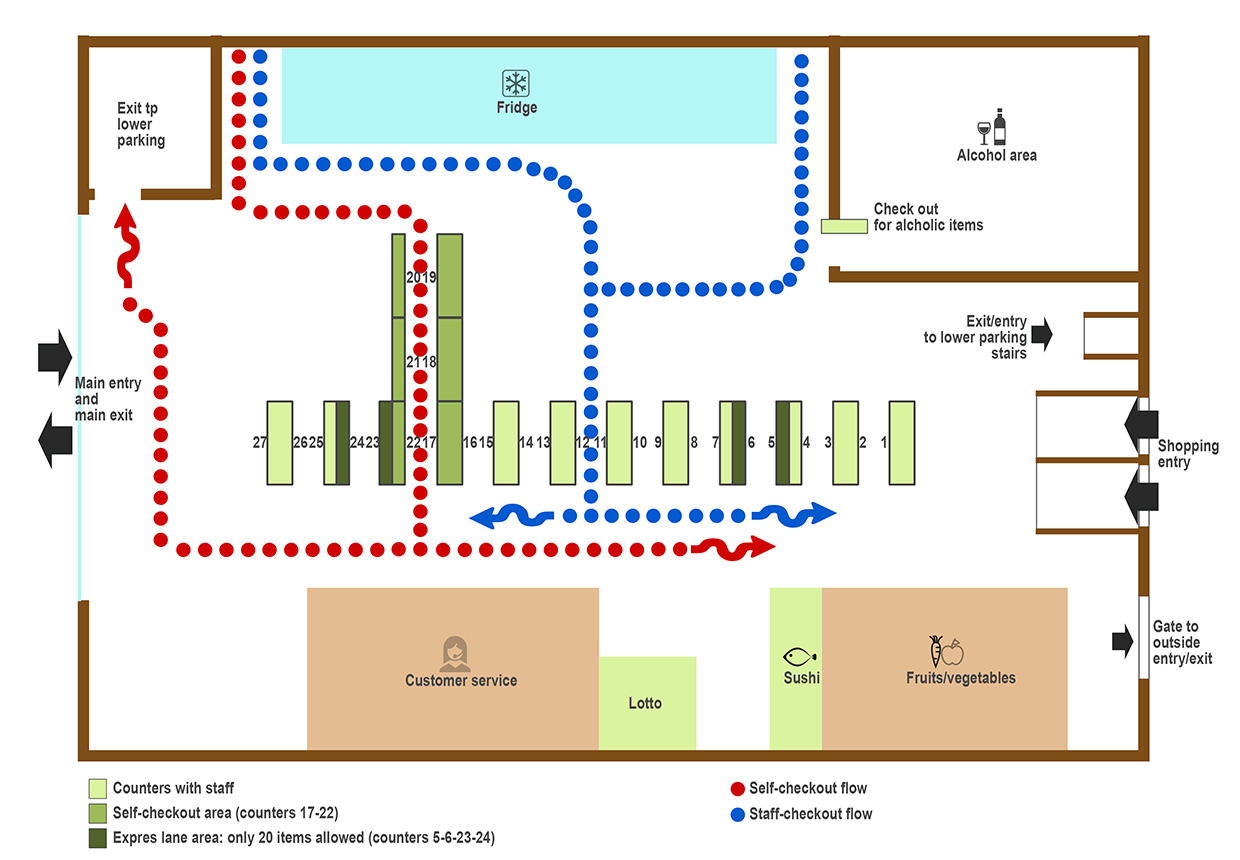
Customer Checkout Process: Self Checkout and Staff Checkout
Two different checkout processes have been analyzed, highlighting similarities and differences in the operational sequences. The following figures and tables have been drafted following the guidelines provided by the course material (Ninow, 2019). Staff checkout and self-checkout are the selected checkout processes.
Figure 2 shows the flowcharts and timelines of staff and self-checkouts.
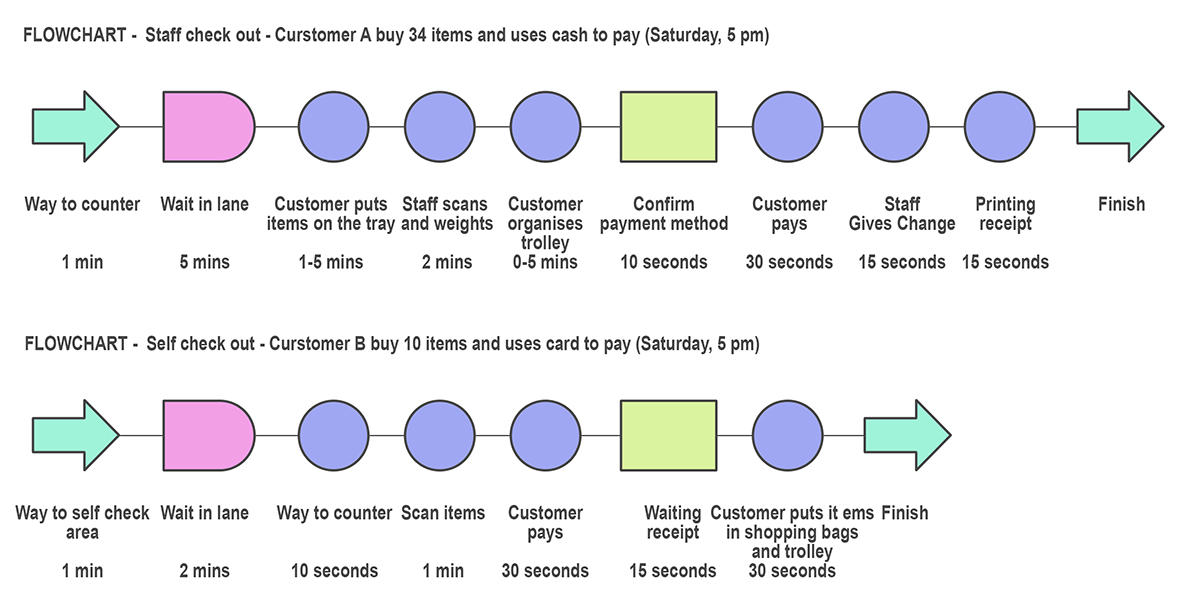
The findings are reported and evaluated in Table 1 and Table 2.
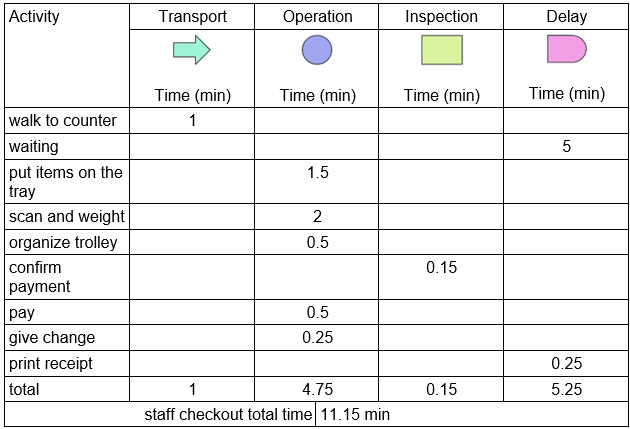
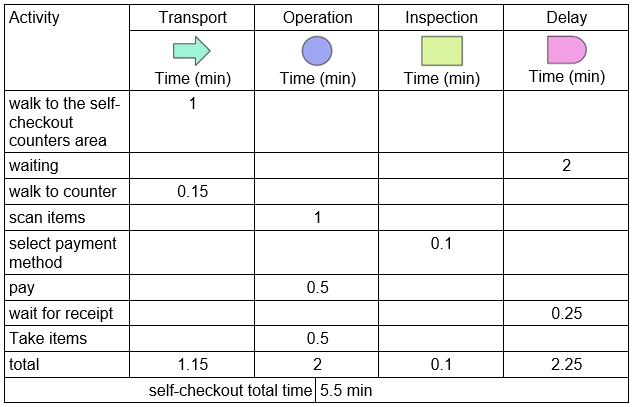
Figure 3, focuses on the staff checkout process, highlighting which activities are performed by the customer and which by the staff. Though some employees were monitoring the self-checkout area, they did not interact with the customer who chose the self-checkout.
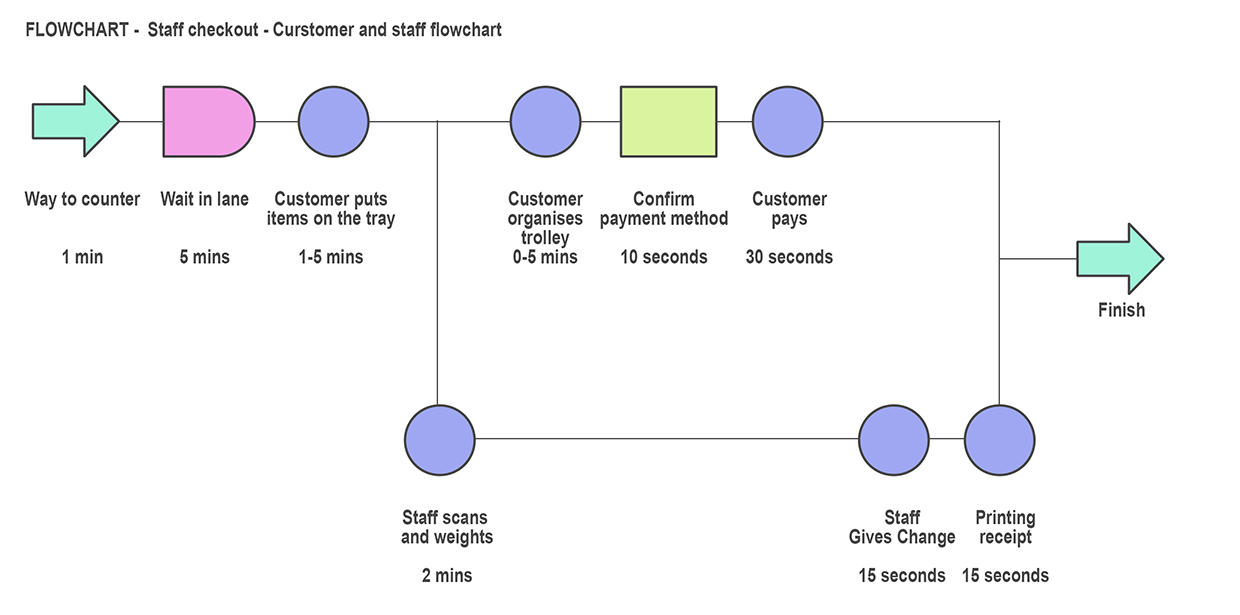
Non Value Added Activities
Non-value added activities could be observed in the checkout processes at the PAK’nSAVE store. Some are related to customers, others to the staff.
Customer Non Value Added Activities
During the staffed checkout, customers might forget the pin code to perform the payment, looking for wallets, having hitches with bags, or trolley. At the self-checkout, a larger number of nonvalue added activities can occur, including doubts concerning the counter and its working; they might need to read the instructions or cannot properly put the items to be scanned.
Staff Non Value Added Activities
During the staffed checkout, the staff needs to weight vegetables and fruits and to print receipts for each customer. They might have problems in scanning a bar-code, in determining a kind of vegetable or fruit (for example, if there are five types of red apples and the customer does not remember the quality), or in organizing the queue if customers are slow in collecting their items. In the self-checkout, the staff might be involved to clarify instructions, reset the machine, and help the customers with the pin code.
Possible Improvements
Findings show that the self-checkout process is consistently quicker than the checkout performed by the staff. Some improvements might be suggested.
- All the counters should be open when the store is crowded to reduce the waiting time.
- The checkout process will be narrowed if the staff does not need to weight fruits and vegetables. A series of scales placed in the vegetable/fruit area would allow the staff to save time.
- The same idea should be implemented in candy and nut compartments.
- Wireless scan devices should be used in case of heavy items, eliminating the need to put them on the tray and back into the trolley.
- A better dislocation of the trolleys would improve the usability of the space. A trolley area in the center of the store would allow employees and customers to get a trolley easily and quickly.
- Modern payment methods, including smartphone apps, would reduce the occurrence of delays due to customers forgetting the card pin code or losing the wallet.
- The staff could reduce the time for printing the receipts for those customers who do not use PAK’nSAVE’s petrol station.
Already Implemented Ideas
Some ideas have been already implemented by the PAK’nSAVE’s management, including a clear displacement of the various zones within the store. Fridge products, vegetables and fruits, alcohol, and customer service are identifiable. Also, the alcohol zone is separated from the rest of the store, with a dedicated checkout for the ID checking process, which a consistent sparing time at the main checkout area.
Operations Management Concepts
Some operation management concepts have been successfully applied within the PAK’nSAVE store in Mount Albert. First, the store is located in a convenient area for incoming items, reducing the time and costs of transport (Zhang, Nishi, Turner, Oga, & Li, 2017). A store with a consistent movement of goods and numerous operations of loading and unloading needs to be located near the main routes of communication. Also, PAK’nSAVE is moving towards a food offer that privileges healthy lifestyle choices. The retail environment plays a key role in potential public health interventions (Vandevijvere, Waterlander, Molloy, Nattrass, & Swinburn, 2018). PAK’nSAVE is following the global trend, showing forecasting ability, potentially attracting new customers.
Conclusion
The research conducted on the PAK’nSAVE store at Mount Albert near Auckland shows a positive balance from an operational management perspective. The store is conveniently located to ease the supply operations, and the general policy is attentive to keep the cost low while it aims at promoting health and well-being among customers, as suggested by the current trend. As regarding the interactions among customers and staff, the management has already implemented some concepts to improve the service; however, some logistic measures and the adoption of modern technologies would better the interactions further.
References
Ninow, R. (2019). Operations Management [PowerPoint slides].
Our policy. (2019). Web.
Vandevijvere, S., Waterlander, W., Molloy, J., Nattrass, H., & Swinburn, B. (2018). Towards healthier supermarkets: A national study of in-store food availability, prominence, and promotions in New Zealand. European Journal of Clinical Nutrition, 72(7), 971–978. Web.
Zhang, G., Nishi, T., Turner, S. D. O., Oga, K., & Li, X. (2017). An integrated strategy for a production planning and warehouse layout problem: Modeling and solution approaches. Omega, 68, 85–94. Web.